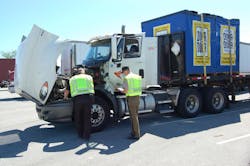“Every year we select a particular are of emphasis, and for 2014 its hazmat,” Steve Keppler, CVSA’s executive director, told me by phone. “We’re encouraging a focus on that.”
Last year, the area of focus centered on changes made to hours of service (HOS) regulations – ensuring drivers in particular knew how the new rules would impact their daily work lives.
[To view more photos from Roadcheck 2013, please click here.]
For 2014, in addition to hazmat – and of course their Level I inspection duties – law enforcement personnel involved in Roadcheck are also going to focus on what Keppler called “educational outreach” to drivers concerning the importance of railroad crossing safety as well as changes that are on the way for the Compliance Safety Accountability (CSA) safety program introduced by the Federal Motor Carrier Safety Administration (FMCSA) four years ago.“CSA is complicated and the more we can help drivers understand what it is – and what it isn’t – the better,” Keppler (at right) said. “In fact ATRI [the American Transportation Research Institute] recently did a study that found awareness of CSA remains low among truck drivers. So we think Roadcheck is a great opportunity to get more information about CSA in the hands of drivers.”
[Keppler by the way strongly believes that if trucking companies focus more on safety, they’ll gain bottom line benefits. For more on his philosophy in this area, go here.]
There will also be greater attention paid to the use of electronic logging devices or “ELDs” that will eventually be mandated in trucking for tracking HOS data, he pointed out. “With more fleets adopting them, we need to add them to our inspection efforts,” Keppler explained.Still, the primary focus of Roadcheck will remain firmly upon driver and vehicle safety inspections this year, in no small part because the rate of out of service (OOS) violations ticked upwards during 2013’s effort.
In 2013, over 10,000 CVSA and FMCSA completed 73,023 truck and bus inspections at 2,500 locations across the U.S., Mexico and Canada during Roadcheck’s 72-hour campaign – with one in five vehicles inspected placed out of service due to a violation serious enough to be considered an imminent safety hazard.
Brakes and tires are particular sore spots when it comes to truck safety, so several suppliers are trying to put helpful information out there so trucking companies can better prepare themselves for this week’s inspection “blitz.”
Fred Andersky, director of government and industry affairs for Bendix Commercial Vehicle Systems LLC, put together these tips on brakes:
- Two levels of maintenance are paramount when it comes to truck brakes: preventive maintenance – the regularly scheduled, thorough review of the vehicle – and the pre-trip visual inspection, in which drivers check for loose hoses, leaks, and other obvious problems.
- In 2013, braking systems accounted for nearly half – 49.6% – of OOS violations issued during Roadcheck and make up 30.1% overall, while brake adjustment violations totaled 19.5%.
- A thorough examination of brake lining thickness and condition is vital to both safety and regulatory compliance. Cracked or worn linings may not provide the stopping power necessary to maintain effective braking power, and brake lining inspections play a role in CSA scoring.
- Correct chamber stroke is just as important as compliant brake linings. Wheel-ends beyond the maximum allowable brake stroke are considered out of adjustment, and under CVSA inspection guidelines, drivers can incur fines if 25% of a truck’s wheel-ends are out of adjustment. During Roadcheck 2013, approximately 3,700 vehicles were removed from service due to out-of-adjustment brakes.
- If your truck is equipped with automatic slack adjusters, do not manually adjust the adjuster. While there are several factors that can cause a brake stroke to be beyond the maximum allowable value, none of them can be fixed by manual readjustment of the automatic slack adjuster.
- Bendix strongly advises fleets and technicians to maintain vehicles using proper replacement parts – ensuring that they meet original equipment manufacturer (OEM) requirements – for best performance and compliance results.
- Relining drum brakes with higher performance friction materials – ones designed to meet new federal stopping distance requirements put in place three years ago – is essential as incorrect or inferior replacement friction material is likely to reduce performance, wear out faster, and create a safety hazard.
When it comes to tires, Love’s Travel Stops is offering a few tips. “Tires are among the highest expenses for fleets and owner-operators. Tires and wheels accounted for 10% of OOS violations during last year’s Roadcheck,” noted Dan Jensen, director of tire sales and service at Love’s. “Our roadside assistance calls increase every year during Roadcheck. We’re happy to assist, but by keeping some simple things in mind, drivers can stay on the road and cut down on costs.”
- Air pressure: Increase the life of your tires and maximize fuel efficiency by making sure your tires are properly inflated. Poorly inflated tires can cause a road failure, as well as decreased tread life, and added stress and possible failure of the casing.
- Alignment: Operating a vehicle without proper alignment causes irregular wear. Driver fatigue can be caused by counter-steering due to alignment issues. A number of things can cause improper alignment at any time. Tires should be monitored for irregular wear and aligned as needed.
- Matching tread depth: Mismatched tread depth can cause excessive and rapid wear. Tires should be matched within 1/8th of an inch (4/32) on an axle.
- Valve caps: Federal DOT regulations require drivers to have valve caps on their tires at all times. A loose or faulty valve cap can result in loss of air and tire pressure, which can cause a tire to fail. Flow through valve caps allows you to check, inflate or deflate tires without removing the cap, which saves drivers time.
And with that, we begin the final countdown to the start of Roadcheck 2014.






